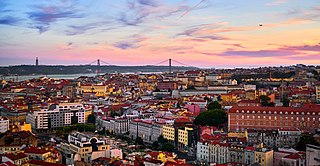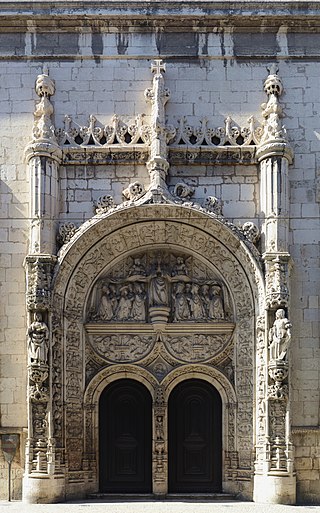
Lisbon is the capital and largest city of Portugal, with an estimated population of 567,131 as of 2023 within its administrative limits and 2,961,177 within the metropolis. Lisbon is mainland Europe's westernmost capital city and the only one along the Atlantic coast, the others being on islands. The city lies in the western portion of the Iberian Peninsula, on the northern shore of the River Tagus. The western portion of its metro area, the Portuguese Riviera, hosts the westernmost point of Continental Europe, culminating at Cabo da Roca.

Pope Benedict XIV, born Prospero Lorenzo Lambertini, was head of the Catholic Church and ruler of the Papal States from 17 August 1740 to his death in May 1758.

DomJohn V, known as the Magnanimous and the Portuguese Sun King, was King of Portugal from 9 December 1706 until his death in 1750. His reign saw the rise of Portugal and its monarchy to new levels of prosperity, wealth, and prestige among European courts.

The Cathedral of Saint Mary Major, often called Lisbon Cathedral or simply the Sé, is a Roman Catholic cathedral located in Lisbon, Portugal. The oldest church in the city, initially built as a mosque, it is the seat of the Patriarchate of Lisbon. Built in 1147, the cathedral has survived many earthquakes and has been modified, renovated and restored several times. It is currently a mix of different architectural styles. It has been classified as a National Monument since 1910.

Cascais is a town and municipality in the Lisbon District of Portugal, located on the Portuguese Riviera. The municipality has a total of 214,158 inhabitants in an area of 97.40 km2. Cascais is an important tourist destination. Its marina hosts events such as the America's Cup and the town of Estoril, part of the Cascais municipality, hosts conferences such as the Horasis Global Meeting.

The Metropolitan Patriarchate of Lisbon is a Latin Church ecclesiastical territory or patriarchal archdiocese of the Catholic Church in Lisbon, the capital of Portugal.

The Santa Justa Lift, also called Carmo Lift, is an elevator, or lift, in the civil parish of Santa Maria Maior, in the historic center of Lisbon, Portugal. Situated at the end of Rua de Santa Justa, it connects the lower streets of the Baixa with the higher Largo do Carmo.

The Church of Nossa Senhora da Conceição is a church in the civil parish of Madalena, in the municipality of Lisbon.

Maria Sophia Elisabeth of Neuburg was Queen of Portugal as the wife of King Peter II from 1687 until her death in 1699. A popular queen, she was noted for her extraordinary generosity and for being the mother of the famously extravagant John V of Portugal.

The Convent of Our Lady of Mount Carmel is a former Catholic convent located in the civil parish of Santa Maria Maior, municipality of Lisbon, Portugal. The medieval convent was ruined during the sequence of the 1755 Lisbon earthquake, and the destroyed Gothic Church of Our Lady of Mount Carmel on the southern facade of the convent is the main trace of the great earthquake still visible in the old city.

The Campo Pequeno Bullring is the current Praça de Touros of the city of Lisbon, in Portugal. It is located in Avenida da República, in Lisbon.

Olivais is a freguesia and typical quarter of Lisbon, the capital city of Portugal. Located in eastern Lisbon, Olivais is west of Parque das Nações, north of Marvila and Alvalade, and east of Lumiar and Santa Clara. The population in 2021 was 32,179.

The Bemposta Palace, also known as the Paço da Rainha, is a neoclassical palace in the area of Bemposta, now the civil parish of Pena, in Lisbon. It was originally built for Queen Dowager Catherine of Braganza on her return from London to Lisbon and served for many years as her residence. It was then transferred to the Casa do Infantado, before becoming the residence of John VI of Portugal until his death. After Queen Maria II of Portugal transferred its title to the Army, it became the Portuguese Military Academy.

The Patriarch of Lisbon, also called the Cardinal-Patriarch of Lisbon once he has been made cardinal, is the ordinary bishop of the Archdiocese of Lisbon. He is one of the few patriarchs in the Latin Church of the Catholic Church, along with the Patriarchs of Venice, the East Indies, and Jerusalem.

Santa Maria Maior is a freguesia and district of Lisbon, the capital of Portugal. Located in the historic center of Lisbon, Santa Maria Maior is to the west of São Vicente, east of Misericórdia, and south of Arroios and Santo António. It is home to numerous historic monuments, including Lisbon Cathedral, the Rossio, and the Praça do Comércio, as well as famous neighborhoods, such as the Lisbon Baixa, as well as parts of Bairro Alto and Alfama. The population in 2011 was 12,822,
Caliabria was a city and the seat of a diocese founded in the 7th century in Visigothic Spain and is now a Latin titular see of the Catholic Church.

Tomás de Almeida was the first Patriarch of Lisbon, formerly Bishop of Lamego and later of Porto. Pope Clement XII elevated him to the cardinalate on 20 December 1737.

The Royal Patriarchal Music Seminary of Lisbon was founded in 1713 by Portugal's king John V to train singers for his Royal Chapel of Saint Thomas at Ribeira Palace.

Principal, or more formally, Principal of the Holy Patriarchal Church of Lisbon, was the honorific title granted to the canons of the chapter of the Patriarchal See of Lisbon by the papal bull Salvatoris nostri Mater, issued by Pope Benedict XIV in 1740.

Américo Manuel Alves Aguiar is a Portuguese prelate of the Catholic Church who has been bishop of Setúbal since 2023. He was an auxiliary bishop of the Patriarchate of Lisbon from 2019 to 2023 and headed the organization responsible for planning World Youth Day in August 2023.



















